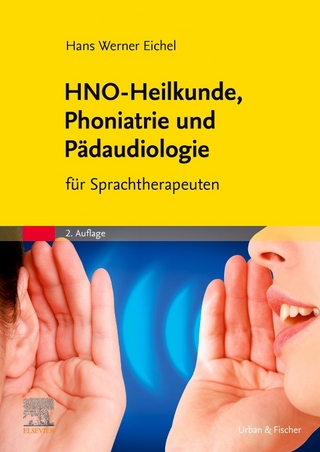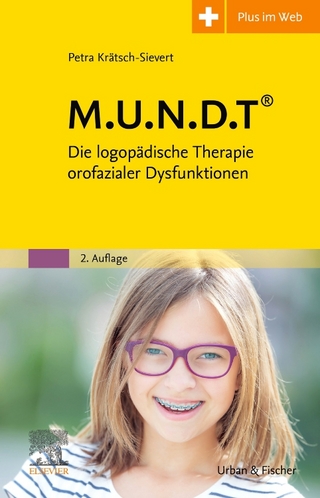
Foundations of Aural Rehabilitation
Plural Publishing Inc (Verlag)
978-1-63550-073-8 (ISBN)
The best-selling textbook, ''Foundations of Aural Rehabilitation: Adults, Children, and their Families, Fifth Edition'', introduces the fundamentals of audiologic rehabilitation and hearing-related speech-language pathology in an easy-to-read, concise resource for the field of communication sciences and disorders. The text offers concrete coverage of theory, clinical practice, and research-based approaches for identifying, diagnosing, and treating hearing and communication-based disorders.
The text is separated into three sections for the most comprehensive coverage of each topic: Part 1 describes the components of an aural rehabilitation plan, Part 2 concerns adults and their family members, and Part 3 concerns children and their parents. Important topics throughout include patient-centered services, counseling, selection and fitting of listening devices, conversational fluency and communication strategies training, auditory training, speechreading, and language and speech promotion.
New to the Fifth Edition:
*Reorganization of chapters to allow a more streamlined presentation of aural rehabilitation for adults
*State-of-the-science review of the most current research in auditory training
*Updated information and references to reflect emerging trends in speech and language therapy
*New larger 8.5" x 11" trim size allowing for better display of text and artwork
*Improved artwork with updated figures and photographs
Key Features:
*Chapters begin with Chapter Outlines and end with Key Chapter Points and Terms and Concepts to Remember
*Numerous case studies, sidebars, and boxes
*Bolded key terms in text with definitions in margins, and a comprehensive end-of-book glossary
*Access to a PluralPlus companion website with supplementary resources for instructors and students
Nancy Tye-Murray, PhD is a Professor at the Washington University School of Medicine in St. Louis, Missouri and an Adjunct Professor at the University of Canterbury in Christchurch, New Zealand. She is the principal investigator of grants from the National Institutes of Health, which provide support for her research in audiovisual speech perception and auditory training. She is the CEO of an Internet company, clEAR (customized learning: Exercises for Aural Rehabilitation; that provides auditory brain training to people with hearing loss. She is also the past president of the Academy of Rehabilitative Audiology, former Hearing Editor for Journal of Speech-Language-Hearing Research, and former Director of Research at Central Institute for the Deaf.
Preface.
Chapter 1. Introduction
The World Health Organization (WHO) and Hearing-Related Disability
Services Included in the Aural Rehabilitation Plan
Where Does Aural Rehabilitation Occur?
Who Provides Aural Rehabilitation?
Hearing Loss
Service Needs
Cost-Effectiveness and Costs
Evidence-Based Practice
Case Study: Applying the WHO’s International Classification of Functioning, Disability and Health
Case Study: Evidence-Based Practice Decision Making
Final Remarks
Key Chapter Points
Terms and Concepts to Remember
Appendix 1-1
Appendix 1-2
Appendix 1-3
Part One: The Components of the Aural Rehabilitation Plan.
Chapter 2. Assessing Hearing Acuity and Speech Recognition
Review of the Audiological Examination and the Audiogram
Purpose of Speech Recognition Testing
Patient Variables
Stimuli Units
Test Procedures
Difficulties Associated with Speech Recognition Assessment
Multicultural Issues
Case Study: Reasons to Go with a Test-Battery Approach
Final Remarks
Key Chapter Points
Terms and Concepts to Remember
Key Resources
Chapter 3. Listening Devices and Related Technology
Hearing Aids
Cochlear Implants
Hearing Assistive Technology Systems (HATS) and Assistive Listening Devices (ALDs)
Computer-Based Technology
Case Study: Audio Technology
Case Study: Listen to the Music
Final Remarks
Key Chapter Points
Terms and Concepts to Remember
Chapter 4. Auditory-Only Speech Perception and Auditory Training
Historical Notes
Listening to Speech with a Hearing Loss
Candidacy for Auditory Training
Brain Plasticity and Auditory Training
Theoretical Underpinnings for Auditory Training
Auditory Training to Improve Speech Recognition
Auditory Training to Improve Music Perception
Benefits of Auditory Training
Case Study: Learning to Hear Again
Final Remarks
Key Chapter Points
Terms and Concepts to Remember
Chapter 5. Audiovisual Speech Perception and Speechreading Training
Speechreading for Communication
Characteristics of a Good Lipreader
What Happens When Someone Lipreads?
The Difficulty of the Lipreading Task
What Happens When Someone Speechreads?
Importance of Residual Hearing
Factors that Affect the Speechreading Process
Assessing Vision-Only and Audiovisual Speech Recognition
Traditional Methods of Speechreading Training
Speechreading Training Today
Efficacy of Speechreading Training
Oral Interpreters
Case Study: An Exceptional Lipreader
Final Remarks
Key Chapter Points
Terms and Concepts to Remember
Chapter 6. Communication Strategies and Conversational Styles
Conversation
Facilitative Communication Strategies
Repair Strategies
Stages of Communication Breakdown
Research Related to Repair Strategy Usage and Communication Breakdowns
Conversational Styles and Behaviors
Case Study: A Couple Conversing
Final Remarks
Key Chapter Points
Terms and Concepts to Remember
Chapter 7. Assessment of Conversational Fluency and Communication Difficulties
Conversational Fluency
General Considerations for Evaluating Conversational Fluency and Hearing-Related Disability
Interviews
Questionnaires
Daily Logs
Group Discussion
Structured Communication Interactions
Unstructured Communication Interactions
The Significant Other
Case Study: He Says, She Says
Final Remarks
Key Chapter Points
Terms and Concepts to Remember
Chapter 8. Communication Strategies Training
Self-Efficacy
Issues to Consider When Developing a Training Program
Getting Started
Model for Training
Short-Term Training
Communication Strategies Training for Frequent Communication Partners
Program Evaluation
Benefits of Training
Case Study: Patients with an Increased Sense of Self-Efficacy
Final Remarks
Key Chapter Points
Terms and Concepts to Remember
Key Resources
Chapter 9. Counseling, Psychosocial Support, and Assertiveness Training
Who Provides Counseling, Psychosocial Support, and Assertiveness Training?
The Patient’s Story and Narrative Therapy
Counseling
Psychosocial Support
Assertiveness Training
Related Research
Case Study: Solving Challenging Situations
Final Remarks
Key Chapter Points
Terms and Concepts to Remember
Key Resources
Part Two: Aural Rehabilitation for Adults.
Chapter 10. Aural Rehabilitation Plans for Adults
Prevalence of Hearing Loss Among Adults
Characteristics of Adult-Onset Hearing Loss
Who is This Person?
Where is the Patient in the Journey?
A Patient-Centered Approach
The Aural Rehabilitation Plan
Case Study: A Road Map for Success
Final Remarks
Key Chapter Points
Terms and Concepts to Remember
Key Resources
Appendix 10-1
Chapter 11. Aural Rehabilitation Plans for Older Adults
Activity Limitations and Participation Restrictions
Audiological Status and Otologic Health
Life-Situation Factors
Physical and Cognitive Variables
The Effects of Untreated Hearing Loss
Aural Rehabilitation Intervention
Third-Party Disability
Aural Rehabilitation in the Institutional Setting
Case Study: Staying Active
Final Remarks
Key Chapter Points
Terms and Concepts to Remember
Key Resources
Appendix 11-1
Part Three: Aural Rehabilitation for Children
Chapter 12. Detection and Confirmation of Hearing Loss in Children
Detection of Hearing Loss
Confirmation of Hearing Loss
Health Care Follow-Up
Parent Counseling
Case Study: A Memorable Journey
Final Remarks
Key Chapter Points
Terms and Concepts to Remember
Key Resources
Appendix 12-1
Appendix 12-2
Chapter 13. Infants and Toddlers
Legislation Concerning Children Who Have Hearing Loss
The Individualized Family Service Plan (IFSP)
Communication Mode
Listening Device
Early-Intervention Programs
Parental Support
Auditory Training for Infants and Toddlers
Case Study: A Mother’s Karma
Final Remarks
Key Chapter Points
Terms and Concepts to Remember
Appendix 13-1
Appendix 13-2
Chapter 14. School-Age Children
The Beginnings of Education for Children Who Are Deaf and Hard of Hearing in the New World
Creation of An Individual(ized) Education Plan (IEP)
The Multidisciplinary Team
School and Classroom Placement
Amplification and Assistive Listening Devices
Classroom Acoustics
Other Services
Children Who Have Mild or Moderate Hearing Loss or Unilateral Hearing Loss
Case Study: IDEA(S) for All Children
Final Remarks
Key Chapter Points
Terms and Concepts to Remember
Key Resources
Appendix 14-1
Chapter 15. Speech, Language, and Literacy
Speech Characteristics
Language Characteristics
Literacy Characteristics
Speech and Language Evaluation
Literacy Evaluation
Speech and Language Therapy
Case Study: Writing Samples from 10- and 11-Year-Old Children
Final Remarks
Key Chapter Points
Terms and Concepts to Remember
Glossary.
References.
Index.
| Erscheinungsdatum | 25.01.2019 |
|---|---|
| Verlagsort | San Diego |
| Sprache | englisch |
| Maße | 216 x 279 mm |
| Themenwelt | Medizin / Pharmazie ► Gesundheitsfachberufe ► Logopädie |
| Medizin / Pharmazie ► Medizinische Fachgebiete ► HNO-Heilkunde | |
| ISBN-10 | 1-63550-073-7 / 1635500737 |
| ISBN-13 | 978-1-63550-073-8 / 9781635500738 |
| Zustand | Neuware |
| Haben Sie eine Frage zum Produkt? |
aus dem Bereich


